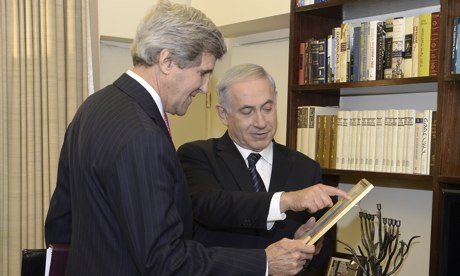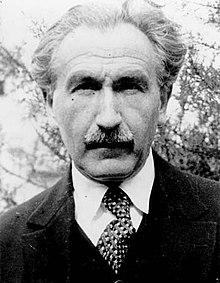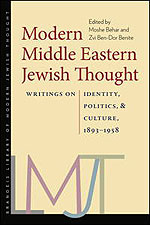The myth of an undivided Jerusalem is collapsing under its own weight
 Friday, January 10, 2014 at 06:24PM
Friday, January 10, 2014 at 06:24PM Binyamin Netanyahu is misguided to believe a two-state Israel-Palestine solution is possible while keeping a deeply divided city intact
by Daniel Saideman The Guardian:Comment is Free 8 January 2014

As John Kerry's Israeli-Palestinian peace initiative moves into a decisive stage, two Jerusalem truths are becoming crystal clear. First, either the two-state solution will also take place within Jerusalem, or there will be no two-state solution at all. Second, any attempt to reach a permanent status agreement regarding Jerusalem that ignores the already existing, deeply rooted urban realities of this bi-national and divided city is doomed to failure.
These truths were on display on 22 October 2013, when Jerusalem held mayoral elections. The incumbent mayor, Nir Barkat, an up-and-coming political star in Israel's ideological right, was re-elected. His victory was convincing: Barkat received 51.9% of the vote, in comparison with the 44.6% received by his closest rival.
Barkat, along with the Israeli prime minister, Binyamin Netanyahu, is a vocal champion of "Jerusalem-the-eternal-capital-of-Israel-that-will-never-be-divided". Conceding that there have long been major inequities in the level of services between East and West Jerusalem, Barkat proudly claims to have made progress in narrowing the gaps, asserting that his efforts have met with satisfaction from Palestinian residents. Citing this accomplishment, Barkat claims to represent all residents of his city, both Israeli and Palestinian, and has said: "The vast majority of the Arabs in Jerusalem prefer to be on the Israeli side. They don't want the city divided."
At first glance, the 2013 municipal election results appear to support such claims. The number of votes Barkat received from the Palestinian sector in this election was 90% higher than what he received in 2008, winning him 46.9% of votes cast by Palestinians of East Jerusalem. Receiving a percentage of the vote slightly below that which he received from the Israeli sector, Barkat was well ahead of his closest rival, who received only 19.7% of the Palestinian vote.
A more careful look at the numbers, however, tells a very different story. There are approximately 157,382 eligible voters among the Palestinians of East Jerusalem. Of these, a total of 1,101 voted in the 2013 election – meaning a Palestinian voter turnout of only 0.7%. Barkat received 46.9% of these votes – a total of 516 votes, a mere 0.3% of the total vote of all eligible Palestinian voters. In short, Barkat's assertion that he "represents" all residents of Jerusalem is without basis in fact.
Some will argue that Palestinian residents of Jerusalem were intimidated into boycotting the election. This assertion is baseless. All organs of Palestinian authority and political organising in East Jerusalem have been crushed by the government of Israel. There is simply no Palestinian capacity in East Jerusalem to organise a campaign of intimidation, or of anything else of consequence. The Palestinians didn't vote in this election, just as they have refrained from voting in previous municipal elections, because they were making a statement about their own identities: "we are Palestinian, not Israeli".
The results in Israel's national elections for the Knesset, which took place on 22 January last year, are no less illuminating. In those elections, 28.4% of eligible Palestinian voters in East Jerusalem cast a ballot, a seemingly respectable number. A more careful look, once again, tells a different story – in this case a story of formal disenfranchisement.
Out of the approximate 157,382 Palestinian residents of Jerusalem of voting age, only 10,431 actually have the right to vote in Israel's national elections (a number that is artificially high, since it includes thousands of Israeli Arab citizens who moved to Jerusalem from areas in pre-1967 Israel, rather than native Palestinian East Jerusalemites). This means that the number of East Jerusalemite Palestinians entitled to vote in national elections hovers at around 5% of the voting-age Palestinian population of the city. Only 2,965 of the East Jerusalem Palestinians – 1.9% of the Palestinian population – voted in Israel's 2013 national elections, with another 95% denied the right to vote.
This bizarre situation exists because most Palestinians in "undivided Jerusalem" are legally classified as "permanent residents", rather than citizens of Israel. As such, they do not enjoy the right to vote in national elections. An estimated 13,000 Palestinians of all ages, out of a total Palestinian population of 293,000 (37% of Jerusalem's total population), have received Israeli citizenship.
By disenfranchising Palestinians of East Jerusalem from national elections, Israel has declared unequivocally that these residents of Israel's "undivided capital" are not, in fact, part of Israel's body politic. And by overwhelmingly refraining from voting in municipal elections, even when that right exists, Palestinians of East Jerusalem are emphatically agreeing.
The results of these two recent elections reveal the fundamental political truth of contemporary Jerusalem: the only place where Jerusalem is "the undivided capital of Israel" is in the fertile imaginations of ideologues such as Netanyahu and Barkat. Nowhere else in the world is there a prime minister so utterly detached from the daily realities of a city that he claims to be his nation's "exclusive" capital; and nowhere else is there a mayor so utterly disconnected from – and in denial about – the realities of the flesh-and-blood city over which he purports to preside.
Those engaged in the current negotiations can ignore these facts only at great peril. When Netanyahu says he supports the two-state outcome, but opposes anything less than an undivided Jerusalem under sole Israeli sovereignty, he is really saying: "I reject the two-state solution".
The myth of "undivided Jerusalem" is collapsing under the weight of its own fictions. Should the Kerry initiative – the last, best hope for the two-state solution – end in failure, Jerusalem will degenerate into the epicentre of a festering conflict, the arena of recurrent rounds of convulsive violence. But should, against all odds, these talks end in agreement, a new Jerusalem, rooted in its genuine political and urban realities, will emerge: a politically divided, bi-national city, the respective capitals of Israel and Palestine – which is the sine qua non of any permanent status agreement.
---------------------------------------------------------------------------------------------------------------------------------
 APJP | Comments Off |
APJP | Comments Off | 





 Moshe Behar and Zvi Ben-Dor Benite present Jewish culture and politics situated within overlapping Arabic, Islamic, and colonial contexts. The authors invite the reader to reconsider contemporary evocations of Levantine, Mizrahi, and Arab Jewish identities against the backdrop of writings by earlier Middle Eastern Jewish intellectuals who critically assessed or contested the implications of Western presence and Western Jewish presence in the Middle East; religion and secularization; and the rise of nationalism, communism, and Zionism, as well as the State of Israel.
Moshe Behar and Zvi Ben-Dor Benite present Jewish culture and politics situated within overlapping Arabic, Islamic, and colonial contexts. The authors invite the reader to reconsider contemporary evocations of Levantine, Mizrahi, and Arab Jewish identities against the backdrop of writings by earlier Middle Eastern Jewish intellectuals who critically assessed or contested the implications of Western presence and Western Jewish presence in the Middle East; religion and secularization; and the rise of nationalism, communism, and Zionism, as well as the State of Israel.